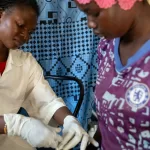Forget sneakers or cleats and put on those boogie shoes—new research from Northeastern University suggests that dancing can offer the same health benefits as running and other forms of exercise.
“You don’t necessarily need to have music, you don’t need to have any training or a teacher—anyone, ostensibly, can dance right where they are and get a health-enhancing dose of physical activity,” said Aston McCullough, assistant professor of physical therapy, human movement, and rehabilitation sciences at Northeastern.
McCullough’s study, published in the journal PLOS ONE, adds to the growing body of evidence that dance can improve heart health, balance, flexibility, and psychological well-being. However, prior studies have primarily examined structured dance forms like ballet or hip-hop, leaving a gap in understanding the benefits of free-form, unstructured dancing.
To address this, McCullough and his team studied 50 participants, aged 18 to 83, with varying levels of dance experience. Participants engaged in self-determined moderate and vigorous free-form dance sessions, both with and without music. Researchers measured heart rates, perceived exertion, and oxygen levels to determine the intensity of their movements.
The findings were compelling: dancing—even without music—exerted enough energy to meet the recommended levels of moderate to vigorous physical activity. Trained and untrained dancers alike achieved similar levels of exertion, while music encouraged participants to move more intensely.
McCullough emphasized the accessibility of dance as a form of exercise. “People can dance without leaving their homes, people can dance without leaving a chair,” he said. “So, in that way, we’re really excited about the benefits of dance for all people. Whatever may be your preferred way to dance, just make sure you have enough space around you to dance safely.”
However, dance alone may not be a complete exercise regimen. The Office of Disease Prevention and Health Promotion recommends that adults include muscle-strengthening activities, such as resistance or weight training, at least twice a week. While some dance forms, like breakdancing, incorporate bodyweight resistance training, more research is needed in this area.
Disclaimer: This article is for informational purposes only and does not constitute medical advice. Readers should consult a healthcare professional before starting any new exercise regimen.











